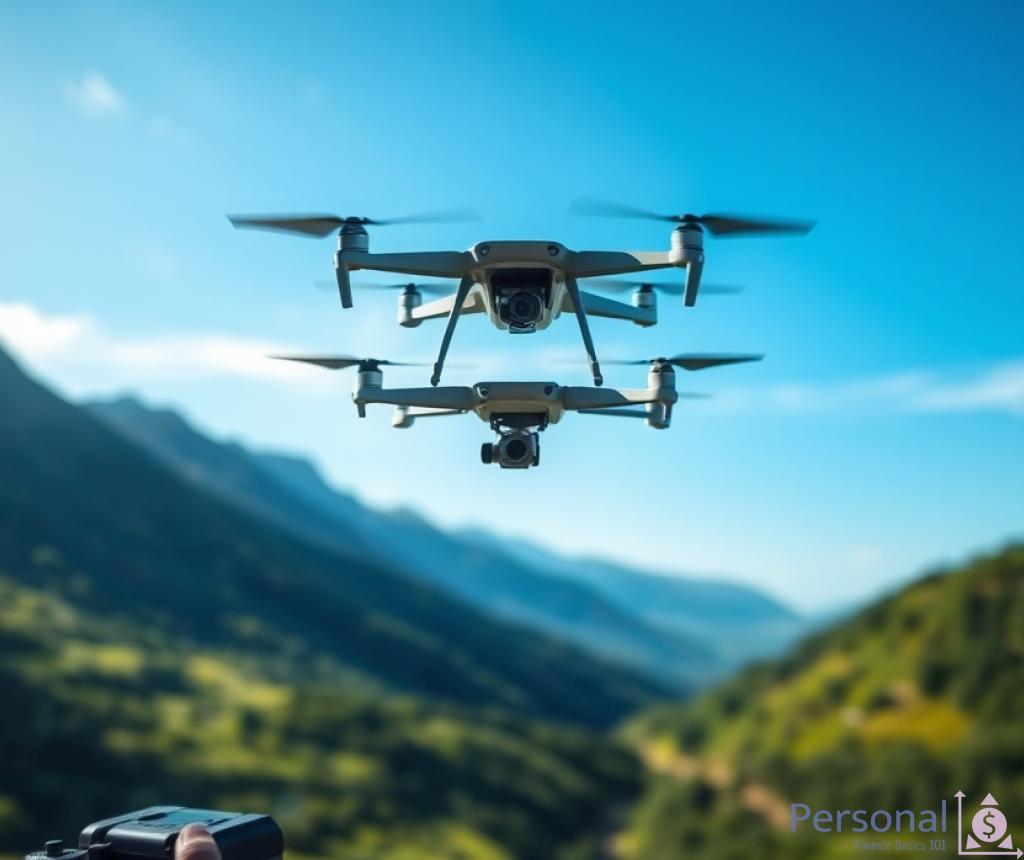Understanding Drone Photography Basics

In recent years, drone technology has revolutionized the way we capture images from above. Once a tool reserved for the military and specialized industries, drones are now accessible to hobbyists and professionals alike. This democratization of aerial photography has led to a surge in demand for drone photography services, making it a lucrative side gig for many.
Understanding the evolution of drone technology is crucial for anyone looking to delve into this exciting field. As drones become more sophisticated, they offer features that were once unimaginable, allowing photographers to capture stunning images that showcase perspectives previously only attainable through expensive helicopter rentals.
Before embarking on a drone photography venture, it is essential to understand the core components that contribute to striking aerial imagery. These elements not only enhance the quality of the photos taken but also ensure compliance with regulations and safety standards.
- Camera Quality: The camera mounted on a drone plays a pivotal role in the quality of aerial photographs. Higher resolution cameras provide sharper images and superior detail.
- Flight Stability: A drone’s ability to remain steady in the air is vital for capturing clear, blur-free images. Advanced stabilization technologies, such as gimbals, are essential.
- Battery Life: The duration of flight time is limited by battery life. Understanding how to maximize this can make a significant difference in the number of shots captured during a session.
- Regulatory Compliance: Knowing the local regulations governing drone use is paramount. This includes understanding no-fly zones and obtaining necessary permits.
Once you have grasped the basics, it’s time to focus on techniques that can elevate your aerial photography. Captivating images are not just about having the right equipment; they also involve creative thinking and strategic planning.
Here are some tips to enhance your aerial photography:
- Plan Your Shots: Scout locations in advance to identify the best angles and lighting conditions.
- Use Natural Light: Early morning or late afternoon provide softer light, enhancing the richness of colors in your images.
- Experiment with Angles: A unique perspective can make a standard landscape photo extraordinary. Don’t hesitate to try different heights and angles.
- Post-Processing: Editing your images can help to refine them and bring your artistic vision to life.
Essential Equipment for Aerial Imagery
To excel in drone photography and deliver stunning aerial imagery, having the right equipment is essential. This toolkit not only enhances the quality of the photographs but also ensures that the photographer can operate efficiently and safely. Below, we delve into the key components that every aspiring drone photographer should consider when assembling their photographic arsenal.
Choosing the right drone is a critical first step. With various models available, it’s important to select one that meets your specific photography needs. Consider factors such as camera specifications, flight range, and ease of use. Below is a comparison of popular drones among aerial photographers:
| Drone Model | Camera Resolution | Flight Time | Price Range |
|---|---|---|---|
| DJI Mavic Air 2 | 48 MP | 34 minutes | $799 |
| Autel Robotics EVO Lite+ | 50 MP | 40 minutes | $999 |
| Parrot Anafi USA | 32 MP | 32 minutes | $7,000 |
While the drone itself is crucial, the camera mounted on it is equally important. High-quality cameras with advanced features allow for capturing images with incredible detail and vibrancy. Invest in additional lenses or filters that can help in achieving specific effects, such as polarization or ND filters, which help manage exposure in bright conditions.
A successful drone photography session often depends on the right accessories. These tools can greatly enhance your shooting experience:
- Extra Batteries: Longer flight times mean more opportunities to capture diverse shots.
- Carrying Case: A sturdy case protects your drone and equipment during transportation.
- Propeller Guards: Ensuring safety during flight, particularly in crowded or complex environments.
- Landing Pads: These provide a clean surface for takeoff and landing, preserving your drone in muddy or rocky terrains.
In conclusion, investing in quality equipment and accessories is essential for those looking to turn drone photography into a rewarding side gig. By understanding the critical components and making informed choices, photographers can elevate their aerial imagery to new heights.
Marketing Your Drone Photography Services
As the demand for aerial imagery continues to rise, effectively marketing your drone photography services becomes paramount. With a plethora of competitors in the field, distinguishing yourself is essential to attract clients. Here, we explore various strategies to elevate your brand visibility and draw potential customers to your offerings.
In today’s digital age, having a robust online presence is crucial for any business. For drone photographers, this means showcasing your work on various platforms where potential clients are likely to browse for services. Consider the following avenues:
- Website: Create a professional website that features a portfolio of your best work, client testimonials, and a clear description of your services.
- Social Media: Utilize platforms such as Instagram, Facebook, and YouTube to share your aerial imagery. Engaging with followers through regular posts and stories can create a loyal community.
- SEO Optimization: Implement SEO strategies to ensure your website ranks well in search engines. This includes using relevant keywords related to drone photography in your content.
Networking plays a significant role in the growth of your drone photography business. Building relationships with other professionals in related industries can lead to referrals and collaborations. Here are some effective ways to expand your network:
- Local Businesses: Partner with real estate agents, event planners, and tourism boards who may require aerial imagery for their projects.
- Industry Meetups: Attend local photography or drone-related events to connect with fellow enthusiasts and potential clients.
- Online Communities: Join forums and groups dedicated to drone photography where you can share your expertise and learn from others.
Building trust with potential clients is essential for converting inquiries into bookings. One of the most effective ways to establish credibility is through client testimonials and positive reviews. Encourage satisfied customers to share their experiences on your website and social media platforms. Consider creating a dedicated section for testimonials on your website to highlight feedback. Additionally, you can use these reviews in your marketing materials to attract new clients.
Legal Considerations for Drone Operations
As the popularity of drone photography surges, it becomes increasingly crucial for aspiring aerial photographers to understand the legal ramifications of operating drones. Navigating this legal landscape not only ensures compliance but also safeguards your business from potential penalties. This section delves into the essential legal considerations that drone operators must address to sustain a successful photography venture.
In many countries, drone operations are governed by a complex set of regulations aimed at ensuring public safety and privacy. In the United States, the Federal Aviation Administration (FAA) is the primary regulatory body that oversees drone activities. Their guidelines stipulate the need for drone pilots to obtain a Remote Pilot Certificate, which involves passing a comprehensive exam on aviation knowledge and regulations. This certification is not merely a formality; it reinforces the importance of responsible drone operation and promotes safe flying practices. Awareness of these regulations is essential for anyone keen on pursuing drone photography as a side gig.
Beyond operational regulations, drone photographers must be vigilant about privacy laws and property rights. Drones equipped with high-resolution cameras can inadvertently infringe on individuals’ privacy if operated over private property without consent. Many jurisdictions have specific laws regarding aerial surveillance and photography, which can lead to legal disputes if not adhered to. It is imperative that photographers familiarize themselves with these laws to avoid potential lawsuits and maintain ethical standards in their work. Furthermore, obtaining permissions from property owners for aerial shoots can not only protect you legally but also build goodwill and trust in your community.
Moreover, understanding local laws, such as those governing no-fly zones—like near airports, military bases, and densely populated areas—is vital. Operating within these confines not only ensures compliance but also promotes safety, making your drone photography endeavors more sustainable in the long run.
Building a Portfolio for Aerial Photography
In the world of drone photography, a striking portfolio is your business card. It serves as both a showcase of your skills and a reflection of your artistic voice. Crafting a portfolio that resonates with potential clients requires a blend of technical proficiency and creative vision. As you embark on this journey, consider not just the images you capture, but how they work together to tell a cohesive story about your capabilities and style.
When it comes to selecting images for your portfolio, quality trumps quantity. Aim to feature a diverse range of aerial shots that highlight your versatility while maintaining high standards of excellence. Consider including the following types of imagery:
- Landscapes: Showcase expansive views that highlight the beauty of nature from above.
- Architectural Shots: Capture buildings and urban layouts to appeal to real estate and architectural clients.
- Event Coverage: Document special occasions such as weddings or festivals to demonstrate your ability to capture dynamic scenarios.
- Commercial Projects: Include work that illustrates your experience with businesses, such as promotional materials or marketing content.
By curating a selection that not only demonstrates your technical skills but also your artistic vision, you will create a portfolio that stands out in a competitive market.
Once you have crafted a compelling portfolio, it’s time to present it to the world. An online presence is essential in today’s digital landscape. Here are effective strategies to maximize your visibility:
- Professional Website: Invest in a user-friendly website that features your portfolio, biography, contact information, and services offered. Make sure it is visually appealing and easy to navigate.
- Social Media Platforms: Utilize platforms such as Instagram and Facebook to share your work. Regularly engaging with followers can help build a community around your photography.
- Photography Contests: Participate in contests to gain exposure and credibility. Winning or being featured can enhance your portfolio and attract new clients.
By adopting these strategies, you can effectively showcase your aerial photography portfolio and attract potential clients seeking high-quality imagery.
Disclaimer
This article has been created or edited with the support of artificial intelligence and is for informational purposes only. The information provided should not be considered investment advice. Please seek the support of a professional advisor before making any investment decisions.






